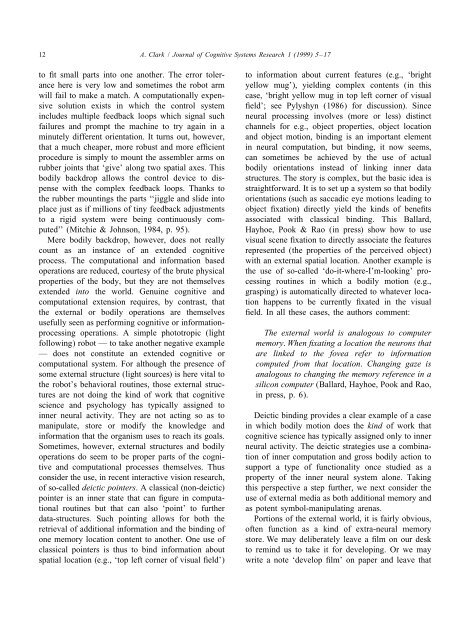Clark, Andy - Where brain body and world collide.pdf
Clark, Andy - Where brain body and world collide.pdf
Clark, Andy - Where brain body and world collide.pdf
Create successful ePaper yourself
Turn your PDF publications into a flip-book with our unique Google optimized e-Paper software.
12 A. <strong>Clark</strong> / Journal of Cognitive Systems Research 1 (1999) 5 –17<br />
to fit small parts into one another. The error toler- to information about current features (e.g., ‘bright<br />
ance here is very low <strong>and</strong> sometimes the robot arm yellow mug’), yielding complex contents (in this<br />
will fail to make a match. A computationally expen- case, ‘bright yellow mug in top left corner of visual<br />
sive solution exists in which the control system field’; see Pylyshyn (1986) for discussion). Since<br />
includes multiple feedback loops which signal such neural processing involves (more or less) distinct<br />
failures <strong>and</strong> prompt the machine to try again in a channels for e.g., object properties, object location<br />
minutely different orientation. It turns out, however, <strong>and</strong> object motion, binding is an important element<br />
that a much cheaper, more robust <strong>and</strong> more efficient in neural computation, but binding, it now seems,<br />
procedure is simply to mount the assembler arms on can sometimes be achieved by the use of actual<br />
rubber joints that ‘give’ along two spatial axes. This bodily orientations instead of linking inner data<br />
bodily backdrop allows the control device to dis- structures. The story is complex, but the basic idea is<br />
pense with the complex feedback loops. Thanks to straightforward. It is to set up a system so that bodily<br />
the rubber mountings the parts ‘‘jiggle <strong>and</strong> slide into orientations (such as saccadic eye motions leading to<br />
place just as if millions of tiny feedback adjustments object fixation) directly yield the kinds of benefits<br />
to a rigid system were being continuously com- associated with classical binding. This Ballard,<br />
puted’’ (Mitchie & Johnson, 1984, p. 95).<br />
Hayhoe, Pook & Rao (in press) show how to use<br />
Mere bodily backdrop, however, does not really visual scene fixation to directly associate the features<br />
count as an instance of an extended cognitive represented (the properties of the perceived object)<br />
process. The computational <strong>and</strong> information based with an external spatial location. Another example is<br />
operations are reduced, courtesy of the brute physical the use of so-called ‘do-it-where-I’m-looking’ proproperties<br />
of the <strong>body</strong>, but they are not themselves cessing routines in which a bodily motion (e.g.,<br />
extended into the <strong>world</strong>. Genuine cognitive <strong>and</strong> grasping) is automatically directed to whatever locacomputational<br />
extension requires, by contrast, that tion happens to be currently fixated in the visual<br />
the external or bodily operations are themselves field. In all these cases, the authors comment:<br />
usefully seen as performing cognitive or informationprocessing<br />
operations. A simple phototropic (light The external <strong>world</strong> is analogous to computer<br />
following) robot — to take another negative example memory. When fixating a location the neurons that<br />
— does not constitute an extended cognitive or are linked to the fovea refer to information<br />
computational system. For although the presence of computed from that location. Changing gaze is<br />
some external structure (light sources) is here vital to analogous to changing the memory reference in a<br />
the robot’s behavioral routines, those external struc- silicon computer (Ballard, Hayhoe, Pook <strong>and</strong> Rao,<br />
tures are not doing the kind of work that cognitive in press, p. 6).<br />
science <strong>and</strong> psychology has typically assigned to<br />
inner neural activity. They are not acting so as to Deictic binding provides a clear example of a case<br />
manipulate, store or modify the knowledge <strong>and</strong> in which bodily motion does the kind of work that<br />
information that the organism uses to reach its goals. cognitive science has typically assigned only to inner<br />
Sometimes, however, external structures <strong>and</strong> bodily neural activity. The deictic strategies use a combinaoperations<br />
do seem to be proper parts of the cogni- tion of inner computation <strong>and</strong> gross bodily action to<br />
tive <strong>and</strong> computational processes themselves. Thus support a type of functionality once studied as a<br />
consider the use, in recent interactive vision research, property of the inner neural system alone. Taking<br />
of so-called deictic pointers. A classical (non-deictic) this perspective a step further, we next consider the<br />
pointer is an inner state that can figure in computa- use of external media as both additional memory <strong>and</strong><br />
tional routines but that can also ‘point’ to further as potent symbol-manipulating arenas.<br />
data-structures. Such pointing allows for both the Portions of the external <strong>world</strong>, it is fairly obvious,<br />
retrieval of additional information <strong>and</strong> the binding of often function as a kind of extra-neural memory<br />
one memory location content to another. One use of store. We may deliberately leave a film on our desk<br />
classical pointers is thus to bind information about to remind us to take it for developing. Or we may<br />
spatial location (e.g., ‘top left corner of visual field’) write a note ‘develop film’ on paper <strong>and</strong> leave that



